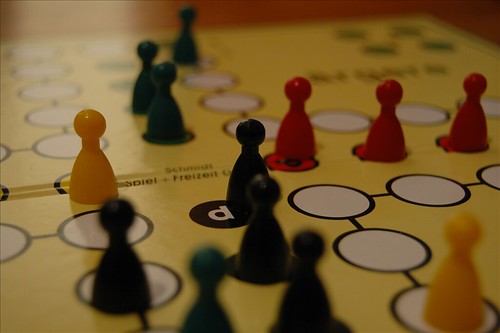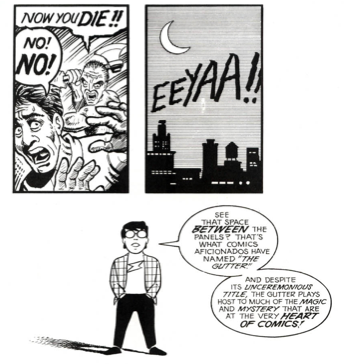“Blood in the Gutter”
– Title of chapter 3, on closure, in Scott McCloud (1993), “Understanding Comcis”, p.60
Why do I prefer using (analog) games and comics to take an introductory look at the concept of a medium, instead of, say, turning directly to networked-digital media (a.k.a. “new media”)?
Networked-digital media are extremly fluid and polymorph, they can simulate any other media and can add networked (shareable, referenceable, distributable), digital (easy copy and modification) or interactive functionality (representing latent/dynamic processes), thus making it quite hard to take a look at the ‘basic’ functions of a medium.
A medium provides a defined and confined space for the generation of meaning out of a selected pattern of noise and vice versa.



Writing and reading, with different types and on different canvas.
(Photos (CC) by i_strad, SpratMackrel, MrRandyPuppy)
(Analog) games and comics share specific aesthetic traits of a medium in quite a pure form – unless they are artistic tries to break up their medial confines.


Boardgames, and boardgames without the boundaries of a board
(Photos (CC) by Feggic and Jason Langheine)
For comics, these medial traits may be closure, simplification, abstraction, separation from the ‘real’ world by being overdrawn. For (analog) games the traits may be their use as an accessible, clearly artificial medium to play a game in, i.e. to express oneself through meaningful moves, though there is always a connection to ‘reality’; explicit medial rules; and using contextualising narratives on how to behave in their confines.
We are closed/open
Text to read
One of the best books – in fact, medium – to explain comics, is Scott McCloud’s “Understanding Comcis”. The title is a hommage to McLuhan’s “Understanding Media”, written three decades before. McCloud not only explains comics, but also aspects inherent to all media and human cognition, aspects like closure or amplification by simplification.
Famous game designers like Chris Crawford and Will Wright (“The Sims”) recommend McCloud’s comic. How come?
- Scott McCloud (1993), “Understanding Comics.” Chapter 2 and 3 [XXX]
- Chris Crawford (1993-1994), “Book Review: Understanding Comics” [X]
“Our industry-culture has raised visual verisimilitude to the status of a stairway to heaven; McCloud’s points might help bring us down to earth. He presents a sequence of decreasingly detailed renditions of a human face. At the left end of the sequence is a photorealistic representation; at the right end is a circle with two dots for eyes and a line for a mouth. “By stripping down an image to its essential ’meaning’, an artist can amplify that meaning in a way that realistic art can’t. … The more cartoony a face is, for instance, the more people it could be said to describe.” ”
– Chris Crawford (1993-93), “Book Review: Understanding Comics”
Could this observation from McCloud be connected to Luhmann’s concept of medium and form? Compare also to Will Wright’s simplified language “Simlish”.
The magic of closure – the invisible workings of a medium
If we talk, there’s magic happening. A sequence of sounds – or letters – become words, and evoke meaning. By saying “egg”, “huevo”, “Muna” or “Ei”, a concept of a white, ovoid form comes to our minds, without there being a necessary connection between the sequence of sounds and its denotation. Where is this connection coming from?
But there’s even more potential magic to discover:
René Magritte (1930): “The Key to Dreams”.
Scott McCloud (1993), “Understanding Comics”, p. 72
“See that space between the panels?” – What about the space between words and images, between the lines of the image, or between the words? Do you see these spaces?
That, what you do not see, is a medium at work: Creating a space for you.
Transfering ideas to a medium, or even a try to represent reality in a medium, requires the artist, edcuator, propagandist to leave out a medium-specific ‘gutter’, where the reader, viewer or learner fill in the gap (e.g. words in a text are not ‘connected’; a camera never shows the place behind the objective; a painting ‘stops’ at its frame).
“You do not see what you do not see.” (Heinz von Foerster) – This is the power of a medium, and the responsibility of an educator, designer or artist: working with and within a blind spot of medial reception, for the learner to discover, and play with.
Task:
What is “closure” (McCloud 1993, “Chapter Three. Blood in the Gutter”)?
There seem to be different kinds of closure, based on the physiological limits of our senses to the limits of our (culturally affected) cognition.
“In electronic media, closure is constant, even overpowering!”
– Scott McCloud (1993), p.65
Can this phenomenon of medium design and medium usage be found in other media as well? what about the internet? If so, could closure be used in learning/teaching?
For a take on closure as predominant in electronic media, see e.g. also “Database as symbolic form” in Lev Manovich (2001), “The Language of New Media.” Cambridge: MIT Press, 2001. [X]
“After the novel, and subsequently cinema privileged narrative as the key form of cultural expression of the modern age, the computer age introduces its correlate – database. Many new media objects do not tell stories; they don’t have beginning or end; in fact, they don’t have any development, thematically, formally or otherwise which would organize their elements into a sequence. Instead, they are collections of individual items, where every item has the same significance as any other.”
– Lev Manovich (2001), “The Language of New Media”, p.194
Task:
Magritte’s “The Key to Dreams” connects arbitrarily objects and names – or rather: their depictions and designations. Does his painting ‘work’ as a medium in its own right? Does it work for you in an artistic or educational way (see learning theories)), and how?
Can you imagine, or do you know similar approaches from artists or educators?
Task:
How can Magritte’s painting “The Key to Dreams” be described in terms of Niklas Luhmann’s (2005) loose and rigid coupling? Is this painting an “abuse of the medium”? Or is this disregard for the relation between signifier and signified a central feature of modern art, art that ‘plays’ with limitations, categories and attributions?

De Saussure (1916): Signifier, signified and sign.
(Graphic from http://massthink.wordpress.com/)
Above: Aram Bartholl (1996), “WoW. Public Intervention”: The artistic re-creation of signifier, signified and sign.
(Photo from http://datenform.de/wow.html)
But what are signifiers, what signified, what signs in a virtual world, with virtual identities and avatars?
Scott McCloud explains Google Chrome (2008)
(Graphic from http://www.google.com/googlebooks/chrome/small_24.html)





Pingback: Misconceptions and Facts: Lies and Truth About the Business of Modeling
Pingback: freshamateurs954 abdu23na4459 abdu23na83